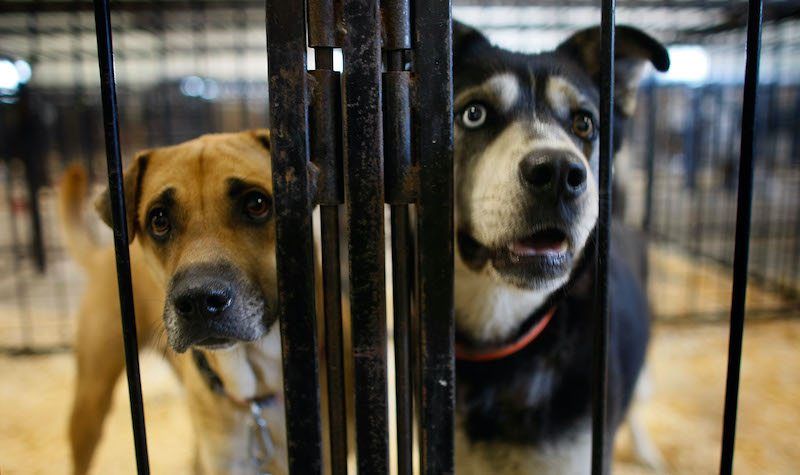
Rescue dog groups may be exacerbating the very problem they claim to address.
Dogs are in.
New homes take in millions of dogs in a typical year, but with the pandemic keeping people at home and in search of companionship, a canine craze has sunk its teeth into the United States.
For dog rescue organizations, keeping up with consumer demand has been a challenge.
“Rescue dogs”—extremely popular among consumers as “an easy way to take feel-good action”—usually refer to dogs adopted from nonprofit organizations that see their mission as one of rescuing dogs from breeders, kill-shelters, or inhumane conditions. These groups often rely on donations and internet fundraising to sustain their work. Some rescue groups focus on a specific breed.
But various animal rights advocacy groups, such as the Humane Society, decry what they view as a lack of regulatory oversight that enables some actors within the dog rescue industry to create a market for some of the same inhumane dog practices that dog rescue groups claim they try to stop.
According to the Humane Society, there are around 10,000 animal rescue groups in North America and around 3,500 brick-and-mortar shelters in the United States that sometimes work with rescue organizations.
Partly because of the success of previous dog rescue efforts, the number of available dogs in the United States has shrunk while demand has grown.
The decline in adoptable dogs has increasingly led rescue groups to turn to the two remaining government-regulated dog auction houses in the United States to purchase animals, according to an investigation published in The Washington Post. According to the investigation, some rescue groups—many rolling in donation cash–try to outbid one another to build their supply of dogs. The auction dogs are allegedly then re-labeled as a “rescue” and sold to a final consumer, sometimes at a profit. The happy owner, thinking they have adopted a “rescue” and averted a canine casualty, may have little way of knowing whether the rescue group paid for the dog or where the dog came from.
According to the owner of Southwest Auction Service—the larger of the two government-regulated dog auctions—some dog rescue groups are “malicious, lying, cheating” organizations that spread lies to increase their bottom line.
In the past decade, dozens of rescue groups have allegedly spent collectively nearly $2.7 million purchasing thousands of dogs at auction, driving a market for breeders. Located in rural Missouri, the two remaining government-licensed dog auction houses host breeders who can sell their dogs to anyone who will pay. Both houses maintain strict rules prohibiting cameras or recordings inside the facility, claiming customers want to avoid being potentially maligned on animal-activist websites.
Although the average price paid per canine is around $465, some rescue groups, padded with donations, routinely pay several thousand dollars for a single dog. And the prices can go even higher: a single Cavalier King Charles Spaniel sold at auction to a rescue group in Alabama for $10,000.
This deceptive cycle of breeder-dog turned “rescue” dog has prompted calls for increased regulation of dog auctions and rescue groups. Mike Bober, president of the Pet Industry Joint Advisory Council—an organization that promotes animal well-being and represents “the pet care community to legislative, regulatory, and governing bodies”—is urging regulators at both the federal and state level to increase governmental oversight of canine transactions.
The two dog auction houses are regulated by both the Missouri Department of Agriculture (MDA) and United States Department of Agriculture (USDA).
USDA is charged with enforcing the Animal Welfare Act (AWA). Enacted in 1966, the AWA is “the only federal law in the United States that regulates the treatment of animals in research, exhibition, transport, and by dealers.” Although dog auctions must be licensed under the AWA and be subject to regular USDA inspections, the Animal Legal and Historical Center notes the licensing requirements are quite broad and that inspection is a “nice word but an unrealistic practice.”
The problem is that there are too few USDA inspectors to ensure breeders are in compliance with the AWA. Moreover, the AWA has historically not applied to nonprofit rescue groups.
Missouri adopted its own set of regulations for anyone acting as a dog dealer or engaged in breeding or auctioning dogs. Administered by the MDA, the Animal Care Facilities Act details licensure requirements for dog dealers, standards that facilities must meet to pass annual inspections, and the penalties—ranging from $1,000 civil fines to criminal punishment—that come from noncompliance.
Although the Animal Care Facilities Act applies in part to dog rescue groups, there are arguably too few MDA inspectors “to make oversight a useful tool.”
The public previously enjoyed access to AWA inspection and enforcement records from the USDA’s website. But soon after taking office, the Trump Administration removed this information, which, according to the Humane Society, made it more difficult to ensure that USDA was “properly regulating and inspecting facilities.”
In response, the Humane Society sued USDA, claiming the agency violated open-records laws by not releasing the inspection and enforcement reports.
USDA, in a possible attempt to address the growing regulatory concerns over dog rescue groups, issued a bulletin suggesting that under the AWA, any “non-profit organization that buys, sells, adopts or transports dogs” may need to “obtain a USDA license or registration.”
Critics of USDA’s announcement claim that targeting rescue groups does not address the underlying problem of excess canines. Although the numbers of dogs have declined dramatically in the past two decades, nearly 700,000 dogs that could not be placed in a shelter or home are still euthanized each year. Requiring rescue groups to obtain a USDA license does nothing to regulate breeders that supply the dogs to the Missouri auction houses, the Humane Society maintains.
Indeed, with adoption rates soaring and consumers willing to pay, the “retail rescue” industry built around buying dogs at auction shows no signs of slowing down.



